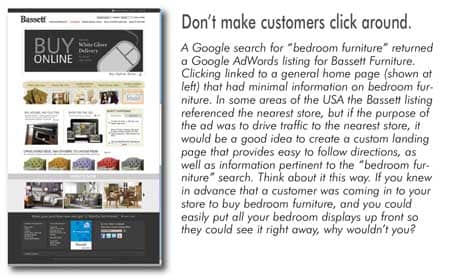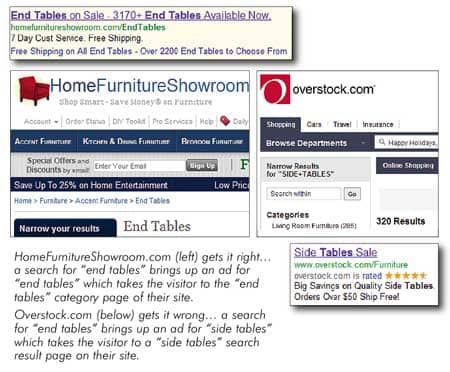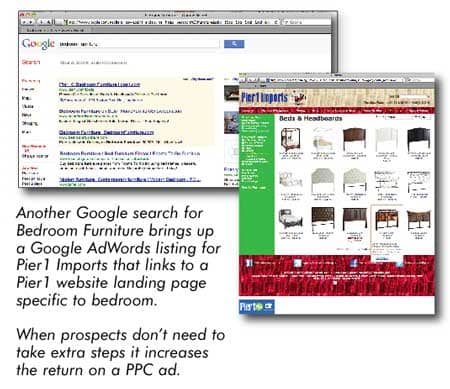Furniture retailers are familiar with spending money to advertise in newspapers and the yellow pages. An advertising rep takes your ad and your money. But with more and more people getting their information from online resources, advertising online has become critical to retailers’ long term survival. Anyone can open a Google AdWords account and start throwing money at the media through a Pay Per Click (PPC) campaign. But if you don’t know what you are doing, you will not get an adequate return on your investment.

This column on New Media Marketing contains a special interview with Tim Seward, an expert on PPC, Google AdWords, and everything involving Paid Search.
Mr. Seward is one of the top authorities in maximizing paid online advertising accounts. In fact, his company ROI Revolutions manages millions of dollars of online advertising spending for companies in 8 countries. His company regularly audits the online advertising accounts of businesses that spend at least $10,000 a month and some that spend over $500,000 in online advertising monthly. You may recognize Timothy if you read publications like Internet Retailer or DM News. He agreed to share with Furniture World readers some of the strategies his company uses to make ad dollars spent in online advertising as efficient as possible.
Managing an online advertising budget has many components, so we limited this article to the important topic of how retailers big and small can see improvement in online advertising ROI by optimizing their e-commerce websites. When a retailer runs a PPC campaign, the goal is to drive traffic to an e-commerce “shopping cart” website. Often though, not a lot of thought is given to what prospects see when they get to a retailer’s website page. This column will, therefore, focus on how furniture retailers can integrate online advertising campaigns with an e-commerce website for maximum results.
Mike: “Welcome Timothy, let’s jump right in. Many furniture retailers know they should be advertising online, but may be intimidated by the process because of the big players who can spend lots of money. What would you tell them?”

Timothy: “It is a brutal fact that every retail industry has three or four top players that dominate their PPC landscape in AdWords. Their ads are always seen while dozens of other businesses are struggling to simply make the minimum first page bid. I tell them you may be fighting the wrong battle. PPC weakness often can’t be solved by simply finding better keywords and writing better ads. The biggest battle in PPC – the place you will gain your biggest competitive edge – often has nothing to do with PPC.
“Sure, we’re online advertising experts at ROI Revolution, but no amount of PPC prowess can overcome the self-sabotage of an underperforming website. In fact, we regularly turn down prospective clients wanting to sign up for our services when we determine they aren’t giving adequate focus to their website strategy. In these cases it is nearly impossible to grow their AdWords account profitably. Over the years we’ve come up with a checklist of sorts to help us determine if a prospect’s website is crippling their opportunity for PPC success.”
Mike: “I would think the first thing someone should do is measure their campaign’s effectiveness. How extensive do you think website analytics needs to go?”
Timothy: “To do it right, a retailer needs to record their website conversion data with granular segmentation by source and cost. It is amazing how many retailers are flying blind with their marketing. With all the precise adjustments necessary in a profitable PPC account, thorough data is imperative. The most successful retailers are tying the gross profit from each subsequent sale back to the original click.
“In addition to a robust web analytics tool such as Google Analytics, you also want to record traffic source information (campaign, keyword, etc.) for each new customer in your CRM system in order to calculate lifetime value by source. You’re paying for traffic according to the profit it brings you, so these metrics are crucial, especially if you close the final order in-store or over the telephone.”

Mike: “Retailers should be measuring all their advertising expenditures with this kind of accuracy, but traditional media does not allow such tracking. Accountability is a big benefit of new media marketing such as PPC advertising. What’s the next question retailers should be asking of their online advertising campaigns?”
Timothy: “Retailers need to consider how deeply their e-commerce landing pages are optimized for PPC traffic. Even if you don’t do e-commerce, the pages the traffic lands on, needs to relate to the content of the PPC ad. While a one-to-one correlation of ad to landing page may be overkill, every major PPC campaign and keyword theme deserves a relevant landing page. Cold traffic converts better with tightly integrated sequences of keywords, ads, and landing pages. You’ll experience greater success when the messaging of each element matches visitor intent.
“This is an absolute must for retailers selling a multitude of products. The good news is that most e-commerce platforms naturally produce adequate PPC landing pages for every product and category. You want to avoid dropping PPC visitors onto a broad category landing page when their initial search query clearly indicated interest in a particular product or brand.”
Mike: “What’s next in website optimization?”
Timothy: “Every website experiences degrees of success. One strategy that can overcome nearly every other website deficiency is a top-down focus on testing and optimization. Even the lowest performing website can be turned around by simply listening to your visitors and existing customers. There are different ways to approach this – listening to sales/support calls, online survey tools, real-time site feedback widgets, and A/B or multivariate testing of your website. When you increase your conversion rate, the value of every visitor increases. All things being equal, a higher converting website allows you to pay more for traffic which increases the flow.
“Landing pages and website order forms typically represent the highest leverage points for optimization. Want to gain or maintain a competitive advantage? Listening to your visitors is mandatory. Dramatic gains are common when your PPC campaigns and your website are being optimized through testing.”
Mike: “This sounds like a lot of work for retailers. But I guess it is somewhat ridiculous to spend thousands of dollars on advertising and not know if you are doing it right or throwing money out the window. Should a retailer step back and look at the big picture of what they truly want to dominate as far as their PPC advertising is concerned?”
Timothy: “Absolutely. Compared with competitors, your current business model may not support PPC domination. All the landing pages and shopping cart optimizations in the world won’t produce the gains required if your customer lifetime value is half that of your competitors. Sometimes you need to step back to ensure your products, offers, and pricing strategies will support aggressive paid search advertising. Don’t be content to optimize copywriting and design details while leaving the bigger elements untested such as product positioning, offer, up sells, and customer follow-up marketing.”
Mike: “At the end of the day it all comes down to profitability. I would think that an e-commerce retailer needs to determine if running a PPC or online advertising campaign is a wise investment in advertising dollars.”
Timothy: “That’s right. Lack of profitability in your current PPC program is often the most telling indicator of an underperforming website. When we take on new online advertising clients, we’re almost always able to increase efficiency and profitability while we grow their account. When you can be profitable your account is ripe for marketplace domination with expert PPC account management. All that’s required is a mutual focus on optimization. Incidentally, our clients often see this as one of the key benefits to outsourcing their PPC – they’re able to redouble their efforts to optimize everything that occurs after the click.”
Mike: “If any Furniture World readers are interested in learning more, what resources can you offer them?”
Timothy: “I can suggest two ways that furniture retailers may be able to learn more about this topic. If they go to:
www.roirevolution.com/FurnitureWorld, there is a free report there entitled: “5 Questions to Maximize Profitability in High Spending AdWords Accounts”. We’ll share with you common mistakes companies make in their AdWords campaigns. While you are on the site if your company spends $10,000 monthly or more for online advertising, you can also sign up for a free 30 PPC Strategy Session. Just let us know that you read about it in Furniture World Magazine.”
Mike: “You also have a very informative blog on your site so the readers should check that out as well.
Thank you so much for your time and insight on some of the strategies furniture retailers should consider to run more profitable online advertising campaigns.”
Timothy: Thanks Mike. “We like providing information to help people get the most out of their online advertising budgets.”
Mike Root is President of Furniture Sales of Mid-America (www.furnituresales.biz), a furniture wholesale and rep company in the Midwest and Rocky Mountain states. His perspective is one of a third generation furniture guy who has been involved in many aspects of the furniture business including furniture retail, wholesale and rental. Mike has his finger on the pulse of the industry by serving on the Executive Committee of the International Home Furnishings Representative’s Association (IHFRA) as well as the CQRID Advisory Board of the Interior Design Society.
Mike has been recognized by the Small Business Administration, the Omaha Chamber of Commerce, and numerous national furniture factories for sales and marketing excellence. Mike helps furniture retailers and factories through his company, Get Customers Right Now build their sales through the use of low cost and no cost direct response marketing strategies including online marketing and social media. If you have questions about this article or other marketing topics, email mroot@furninfo.com or visit www.MikeRoot.com.